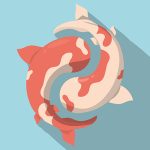 Ever since I can remember, I have enjoyed reconciling spiritual and scientific perspectives.
Ever since I can remember, I have enjoyed reconciling spiritual and scientific perspectives.
As a girl, I used the terms ‘religion and science.’ Many of my peers these days talk about the divine feminine and masculine principles within each of us. Eastern perspectives see the world in terms of yin and yang, and yet to a great degree, they remain essentially divided, with a spot of the ‘other’ in the centre of each.
In everything I do, I strive to find the integration point, to practice and see how these two archetypes can coexist in a single space: human experience and expression.
(If you want to skip right to the point, you can jump to the bottom ↓ of this article.)
History of the Site
ellencarnahan.com has been active in one form or another since December 2004. Initially its purpose was to showcase my professional Portfolio as a Graphic Designer, and for all of the years since that time, it has served in that way. Around 2015 I converted it from html to WordPress, and in 2016 I attempted to establish a regular Artist Blog.
Within a few months, still in 2016, I decided to offer Tarot and Oracle Card Readings, along with Intuitive Readings and Reiki & Rising Star Healings. (I’ve been an Usui Reiki Master/Teacher since 2006.) Much of the writing on those pages stems from that time.
At the same time, I was also going through a particularly intense personal passage, and once I was feeling better, I was inspired to go back to school to earn my Master of Education, which I completed in the Summer of 2022. During my final year of school I also opted for a personal sabbatical, with the intention of letting myself naturally flow into the next thing, rather than making an intellectual decision in rational concordance with my new MEd.
What Does That Have to Do With ‘Callosum’?
I’ve always been a kind of intellectual with an artistic bent, or an artist with an inquiring and logical mind. Take your pick. Some time in the 1990s I was offered a brain ‘test’ on a colleague’s computer, which identified respondents as left- or right-brained based on their answers. My results fell very close to the centre. (There was an additional parameter which turned the results into 4 quadrants, but I forget the second category. I was also close to the dividing line on that scale as well.)
The ‘corpus callosum’ (or ‘callosal commissure’) is the part of the brain at the top of the head, located between and connecting the right and left hemispheres, that handles communication between the left and right hemispheres. Most people are aware that these correspond to mental and artistic tendencies, respectively. Wikipedia publishes a very dry, biological, clinical article on the brain’s components.
In terms of psychology and human behaviour, the so-called “split-brain theory” identifies the difference between these lobes as ‘visual vs. intuitive,’ ‘image vs. language,’ ‘arts vs. science,” or other, similar groupings. Do an Internet search for right and left side of the brain or split-brain theory to see a variety of articles on the topic.
You may come to the conclusion, as I did, that scientists seem hesitant to commit to the left-brain/right-brain notion as a fact of human experience as uncontested as the colour of a sunny sky. Perhaps that explains the rather dry nature of the Wikipedia articles on the brain. In all fairness, ‘science’ is a process rather than a compendium of unassailable facts, and as such is a moving target and open to intelligent and informed debate.
Getting To the Point
 When a person uses their left brain, the kind of thinking and activity achieved is mainly logical, rational, fact-based, or mathematical. When they use the right brain, the dominant mental activity can produce art or music, creative writing or sometimes humour. (Humour can also result from a balanced use of the brain, as in absurdity.)
When a person uses their left brain, the kind of thinking and activity achieved is mainly logical, rational, fact-based, or mathematical. When they use the right brain, the dominant mental activity can produce art or music, creative writing or sometimes humour. (Humour can also result from a balanced use of the brain, as in absurdity.)
In reality, we all use both sides of the brain for every task or activity we perform — just usually in unbalanced of unequal amounts. It is my contention that when they are used in as equal amounts as possible, and a person holds an awareness of that effort, even greater than normal creativity (creative genius) and cognitive leaps (intelligent genius) can be made.
Nearly everything I do follows an effort to find the middle ground: the balance point between rational and creative thinking.
In spiritual circles, the left brain (corresponding to the right side of the body) is associated with the active, masculine archetype (or divine masculine, DM). The right brain (left side) pertains to the perceptive, feminine archetype (divine feminine, DF). People interested in the concept of twin flames (TF) sometimes idealize a union between the two aspects, which also corresponds to an energetic and conceptual unity within the self. In terms of the body, this most closely aligns with the corpus callosum.
Neuroplasticity…
In 1979, artist and fine thinker Betty Edwards published the groundbreaking workbook “Drawing on the Right Side of the Brain.” (The current edition was revised for 1999: The New Drawing on the Right Side of the Brain.) In my view, part of the reason for its popularity was to get people out of their ‘head space’ (left brain) and act with (or ‘exercise’) the creative, or right-brained aspect of the self.
I have a good friend who is recovering from a stroke to their left brain, and I have since learned that practicing a musical instrument (or singing, using the vocal instrument) is often used as a therapy in such cases. It was explained to me that the individual sometimes/often has an easier time ‘singing’ what they want to say than simply ‘saying’ it. When cognitive functions have not been adversely affected, the issue in this case is expression. Musical expression is typically ‘right brained,’ even while language expression is ‘left brained,’ but use of this technique in therapy can often get results this way. Think The King’s Speech. The idea of this as well being to retrain the neural pathways in a way that can help restore some if not all of the compromised function.
Neuroplasticity is defined as the ability for the brain to change and rewire itself through purposive action. Once thought to be completely nonrenewable, it was assumed for a long time that injuries or degradation to the brain were forever. In addition to the hope that neuroplastic therapies bring to people with brain injuries, the concept also has broader implications.
…and Balance
Adherents of martial arts, or nearly any physical sport, understand the benefits, indeed the crucial importance, of balance. Balance as a psychological or spiritual concept (operating on an ‘even keel,’ or noting the cycle of Yin and Yang) is not as commonly discussed, but the principle is the same.
However, sticking with the physical metaphor, over-exercising one side of the body as opposed to the other necessarily results in a visual and functional imbalance. Keeping the flow going from the left to the right side and back, whether in sports or daily movement, or in the use of our brain, can bring us to a place of inner balance, and ideally, peace.
